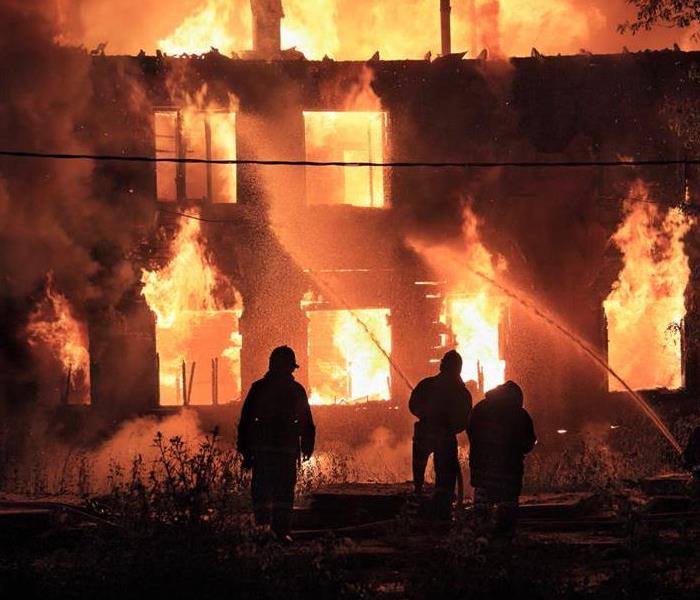Fire Safety Tips for California Residents
12/12/2017 (Permalink)
With the fires that raged in Napa Valley and Sonoma county, and the ones that are currently active in Ventura county and in Los Angeles, fire safety, both from wildfires and accidental home fires, is a real concern for millions of California residents, including those in Palo Alto, Menlo Park, Atherton and Redwood City in Santa Clara County, California.
Due to a combination of reasons, including weather conditions (including lack of rain and lack of humidity), increasing temperatures (global warming), and simple human error or carelessness (tossed cigarettes, illegal bonfires, intentional fire-setting), wildfires have been increasing in number and intensity in recent years. This means that experiencing fire damage is a real possibility for many Californians, including those in many parts of Santa Clara County, California.
There’s also the danger of fires starting in your home from electrical shorts or kitchen fires (the most common cause of in-home fires). According to The Red Cross, “If a fire starts in your home you may have as little as two minutes to escape. During a fire, early warning from a working smoke alarm plus a fire escape plan that has been practiced regularly can save lives.” Two minutes! That’s barely enough time to grab your pets and a couple of beloved belongings and escape. Not to mention dealing with the worry about your home due to fire damage because of fires in Palo Alto, Menlo Park, Atherton or Redwood City.
Here are the top 7 ways to prepare for a home fire from redcross.org:
- Install the correct number of smoke alarms. Install a smoke detector inside each bedroom, outside each sleeping area and on every level of the home, including the basement. On levels without bedrooms, install alarms in the living room (or den or family room) or near the stairway to the upper level, or in both locations. Test your smoke alarm or smoke detector once a month and replace the batteries at least once a year.
- Teach children what smoke alarms sound like, and teach them what to do when they hear one. Practice with them twice-yearly.
- Ensure that all household members know at least two ways to escape from every room of your home, and that you determine a family meeting spot outside of your home in the case of a fire.
- Establish a family emergency communications plan and ensure that all household members know who to contact if they cannot find one another or cannot meet at the predetermined family meeting spot.
- Practice escaping from your home at least twice a year, and at random times. Press the smoke alarm test button or yell “Fire“ to alert everyone that they must get out.
- Make sure everyone knows how to call 9-1-1, no matter how young.
- Teach family members to STOP, DROP and ROLL if their clothes should catch on fire.
The Red Cross also recommends you follow these fire-safe habits:
- Keep items that can catch on fire, like flammable clothing, paper, toys, etc. at least three feet away from anything that gets hot, such as space heaters.
- Smoking paraphernalia is the leading cause of residential fire deaths in the United States. Please do not smoke. If you have to smoke, take precautions: Smoke outside, choose fire-safe cigarettes, don’t smoke in bed, don’t smoke when drowsy or medicated, or if anyone in the home is using oxygen. That’s a disaster waiting to happen.
- Use deep, sturdy ashtrays and douse cigarette and cigar butts with water before disposal.
- Talk to children regularly about the dangers of fire, matches and lighters and keep them out of reach.
- Turn portable heaters off when you leave the room or go to sleep.
- Never leave a burning candle unattended, even for a minute.
Following these fire-safe habits won’t protect you against wildfires, but there are steps you can take to help reduce the risk of fire damage to your home from a wildfire, such as those that have recently been burning in both Northern California and Southern California.
In the last two years, over 67,000 wildfires have been reported across the country each year, many in California. Yearly, wildfires destroy over 4,000 structures, with 3,000 of them residential. As real estate development expands into forests and grasslands, the chances of wildfire related property damage goes up.
You can’t fight back a wildfire that is encroaching on your home or business, but you can take steps to protect yourself and your property. Learn how you can help protect your home or business from a wildfire. Keep you and your family safe and know how and when to evacuate. Learn more in the second part of this blog post, to be continued next week.
If you already have suffered fire damage and need fire restoration, please call SERVPRO of Palo Alto at (650) 800-3448 for a free estimate. Our highly trained technicians use advanced equipment to make it “Like it never even happened.”



 24/7 Emergency Service
24/7 Emergency Service
